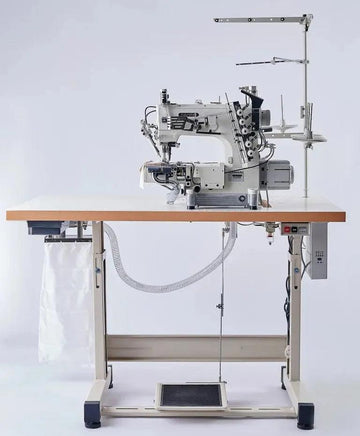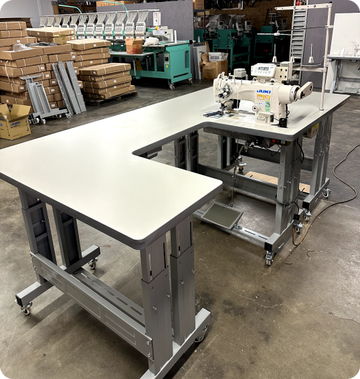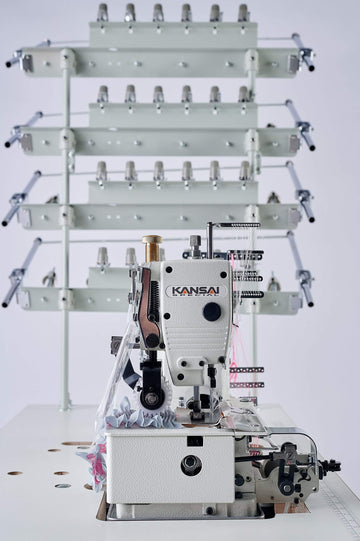In industrial sewing, the discussion around mechanical vs computerized sewing machines is not just theoretical — it directly shapes production quality, operator efficiency, and profitability. Whether you manage a garment factory, a small atelier, or a contract sewing operation, the type of machine you rely on determines how smoothly your business runs day to day.
At Prizzi Sewing, we’ve supplied equipment to hundreds of production sites — from high-speed apparel lines to specialized upholstery workshops — and we’ve seen both systems succeed when matched properly to the job. Here’s a closer look at what really separates mechanical and computerized sewing machines, what’s changing in the industry, and how to decide which setup works best for your operation.
What Actually Differentiates Mechanical and Computerized Machines
The difference between computerized and mechanical sewing machines lies in control and automation.
A mechanical sewing machine is operated entirely by physical controls: knobs, levers, and gears. Stitch length, width, and tension are adjusted manually, and results depend heavily on the operator’s skill.
A computerized sewing machine (sometimes called an electronic or automatic model) uses microprocessors and sensors to control nearly every aspect of sewing. Functions like stitch selection, needle position, and thread trimming can be programmed or recalled from memory.
In a production context, this difference means one machine depends on the operator’s consistency, while the other helps standardize performance automatically.
Why Many Professionals Still Trust Mechanical Machines
Despite the rise of automation, mechanical machines continue to dominate many factory floors. There’s a good reason for that — they’re built to last and easy to service.
Typical strengths:
-
Durability under heavy use: These machines can run long shifts with minimal electronic interference or downtime.
-
Low maintenance cost: Most mechanical parts can be repaired with standard tools and easily available components.
-
Operator control: Skilled machinists often prefer the tactile feel and immediate feedback of mechanical adjustments.
For businesses producing large batches of uniform products — jeans, workwear, or heavy textiles — a mechanical sewing machine vs electronic system often delivers better value and reliability.
The Rise of Computerized and Electronic Systems
In contrast, computerized sewing machines are transforming how modern workshops handle complex or varied production.
Main benefits include:
-
Precision and repeatability: Settings are digitally controlled, which reduces human error and variation between operators.
-
Programmable functions: Patterns, stitch sequences, and seam types can be saved and reused, saving time during style changes.
-
Automatic processes: Thread trimming, backstitching, and presser foot lifting are handled automatically, speeding up production cycles.
-
Data connectivity: Advanced models integrate with production management systems, allowing supervisors to track performance and efficiency.
For ateliers that frequently shift between fabrics or design styles, or for manufacturers handling small production runs with tight tolerances, computerized sewing machine vs manual setups can dramatically increase flexibility and output quality.
Electronic Machines: The Hybrid Solution
Between purely mechanical and fully computerized systems lies the electronic sewing machine — a hybrid that offers the best of both worlds. It maintains manual control for some adjustments but introduces electronic motors for features like needle positioning or speed regulation.
This makes sewing machines mechanical vs electronic models a popular choice for mid-sized workshops that want automation without the complexity or price of a fully digital system.
Read Also: How to Operate a High-Speed Sewing Machine?
Considering ROI and Long-Term Efficiency
When comparing automatic vs manual sewing machines, the conversation inevitably turns to cost. Computerized machines have a higher purchase price, but they often pay for themselves through reduced operator fatigue, fewer errors, and faster turnover.
Mechanical models, however, remain more economical to repair and maintain, especially in locations where electronic servicing may be limited. Each approach has its ideal environment:
-
Mechanical machines for steady, uniform production and robust fabrics.
-
Computerized or automatic machines for varied, design-driven, or precision work.
The right balance depends on your product line, operator skill level, and production scale.
Industry Trends Shaping the Future
The industrial sewing market is evolving fast. Factories are moving toward smart, networked systems that connect machines with digital dashboards, allowing supervisors to monitor output and diagnose issues remotely. At the same time, energy-saving servo motors are replacing traditional clutch drives, cutting electricity costs without compromising power.
Interestingly, there’s also a renewed appreciation for high-end mechanical machines, particularly in regions where maintenance infrastructure for computerized models is limited. At Prizzi Sewing, we’ve noticed many clients adopting a mixed setup: durable mechanical units for base production and computerized machines for detailed finishing or specialty work.
Expert Tips for Choosing the Right Equipment
-
Map your workflow first. Identify which processes are repetitive and which require flexibility.
-
Train your team. Computerized models simplify operation but require initial setup knowledge.
-
Plan for downtime. Keep spare machines or parts available to avoid halts in production.
-
Monitor energy consumption. Servo motors on modern electronic machines can lower your power bills significantly.
-
Think ahead. Choose equipment that can integrate with automation or tracking systems later — future-proofing your investment.
Prizzi Sewing’s Perspective
For over a decade, Prizzi Sewing has worked with manufacturers and ateliers across the textile and furniture industries, supplying both automatic and manual sewing machines tailored to each production need. We’ve seen how the right mix of technology and training can completely transform efficiency and product quality.
Whether you’re upgrading an existing line or setting up a new facility, our team helps identify the ideal balance between mechanical durability and computerized precision. Every recommendation we make is grounded in real factory experience — not theory.
Conclusion: Choosing with Confidence
In the debate of computerized sewing machine vs mechanical, there’s no one-size-fits-all answer. A factory that values endurance and simplicity may never need digital controls, while a custom atelier might rely on them daily for intricate designs.
The key is to align technology with your production goals. Mechanical machines provide dependability and strength; computerized models offer automation and control. Combined strategically, they create a more efficient and resilient sewing floor.
If you’d like to evaluate your current setup or explore suitable upgrades, our experts at Prizzi Sewing are always happy to help.
Visit our website or reach out directly — we’ll help you choose machines that work as hard and precisely as your team does.










